Food in Crete is bursting with intense Mediterranean flavours. Traditional Cretan food is uncomplicated and made from fresh ingredients, many of which are grown in Crete’s natural environment using ‘earth-friendly’ methods.
Agrotourism in Crete is popular, and Cretan tavern and restaurant menus serve locally grown produce and traditional dishes. Cretan food is high quality, plentiful and healthy.
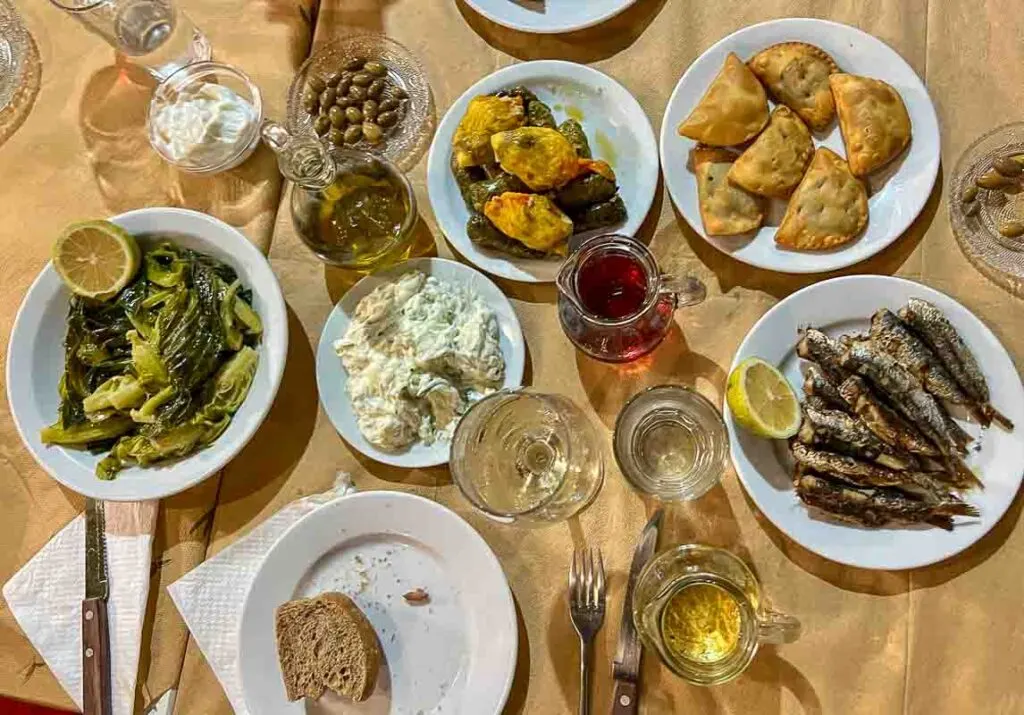
This post may contain affiliate links, which means that we may earn a small commission, at no extra cost to you, for qualifying purchases. More info: disclosure.
Let’s take a look at some of the best food you can enjoy in Crete, from meat dishes like kleftico and stifado, traditional domades and dips, a multitude of vegetable dishes, masses of mezze and, of course those tempting Greek desserts!
Food in Crete, Greece
Contents
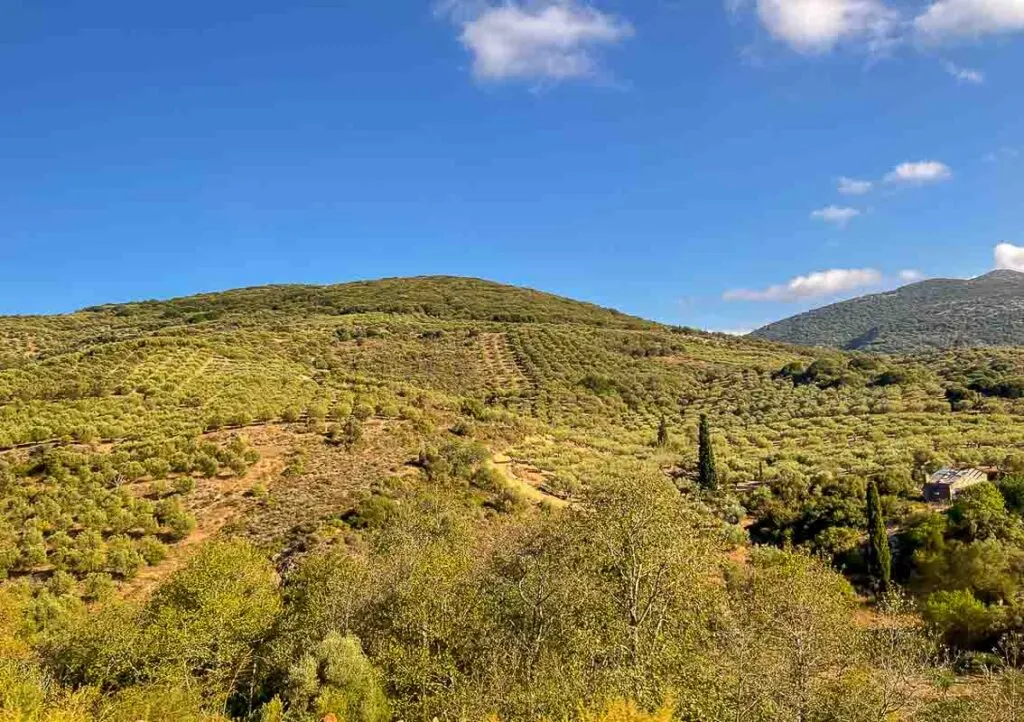
Crete is an incredibly green and fertile island, perfect for farming and growing and it shows in its food.
The Cretan traditional diet usually includes meat dishes featuring local lamb, chicken or pork. As Crete is an island, there’s also plenty of fresh fish on the menu.
Greek food is usually cooked using golden olive oil from the plentiful olive groves, along with lemon juice and a few aromatic herbs for added flavour.
Vegetarians won’t feel left out in Crete; there’s an abundance of seasonal vegetables, including plump ripe tomatoes, gleaming aubergines (eggplant) and yellow-flowered courgettes (zucchini). Horta are fresh greens simply steamed and drizzled with olive oil.
Then there’s the Cretan cheeses, Greek yoghurt, fresh fruits and Greek pastries, strewn with nuts and drizzled with Cretan honey. Not only is the Cretan Mediterranean diet a tasty one, it’s a one healthy too.
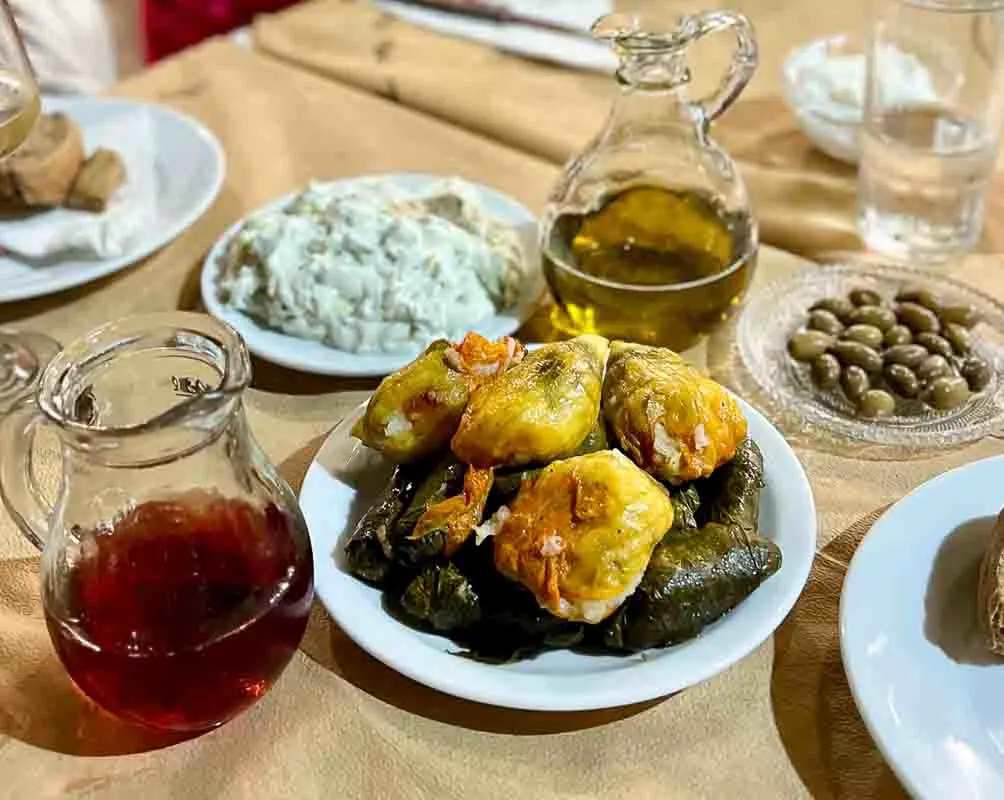
So, what to eat in Crete? Read on for some of the best Cretan cooking…
Mezede or Meze
One of the best ways to get an idea of what you like is to order Meze, which is the Greek version of Spanish tapas. In fact if you go out for a Cretan meal it’ll usually start with a variety of meze starters.
Meze comes from the word ‘Mezedes’, meaning little delicacies. It’s a great way to try several tasty dishes of traditional Cretan cuisine made from high-quality local ingredients. This could be something as simple as slices of cucumber and tomato sprinkled with sea salt, dolmades, dips or a mix-and-match of the following traditional Cretan food.
Dakos
Isdakos or Cretan Dakos is a delicious starter or snack. Cretan twice-baked barley bread, known as barley rusks, (paximadi) is brushed with extra virgin olive oil and topped with chopped, juicy sun-ripened tomatoes. Sometimes crumbly, creamy white cheese myzithra from sheep or goat’s milk is sprinkled on top.
A sprinkling of oregano tops off this tasty dish, and the combination of crisp bread with ripe, juicy tomato really wakes up the taste buds. I swear you can taste the Mediterranean sunshine in Cretan tomatoes!
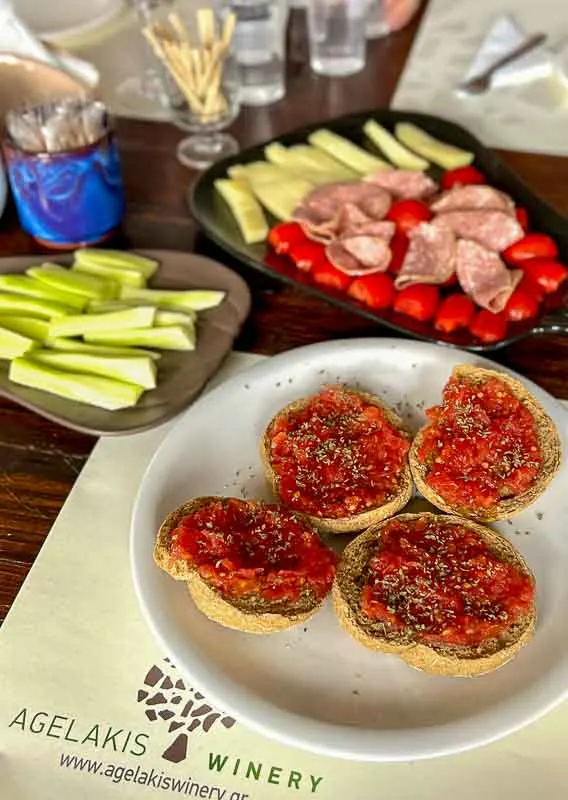
Saganaki
Saganaki are deep-fried slices of cheese, and they are absolutely delicious. Crisp on the outside and warm and chewy inside, these gorgeous snacks are totally irresistible – don’t judge me!
Tomatokeftedes
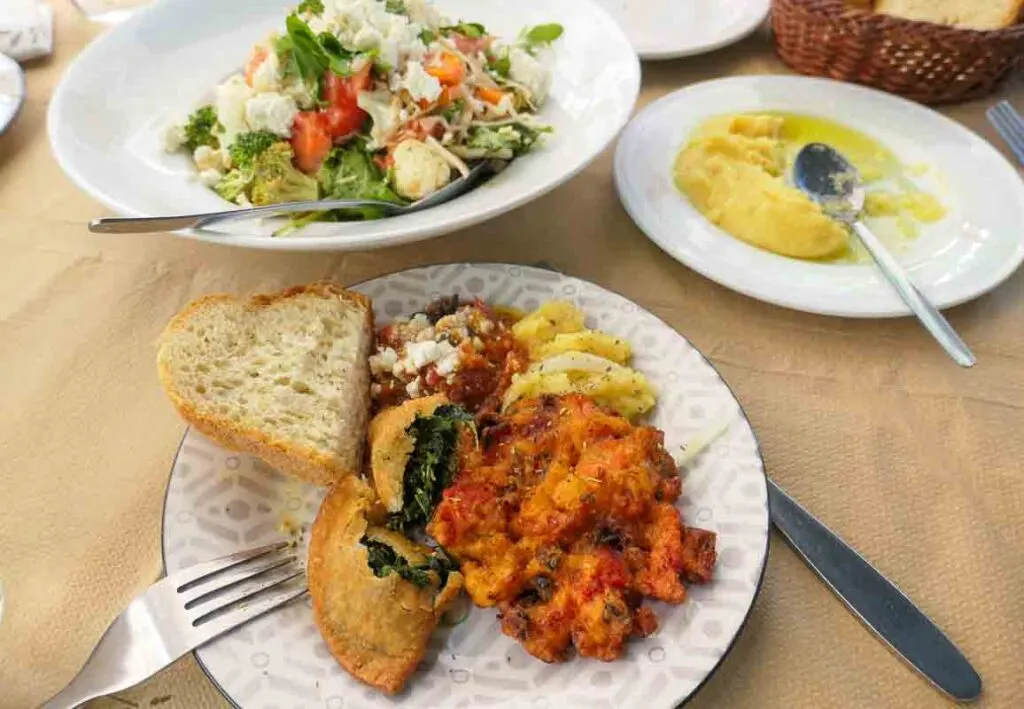
These delicious tomato fritters were a revelation on my visit to Heraklion in Crete. I’d never had them before and they are an absolute delight. They are made with fresh, ripe, sweet tomatoes, flavoured with basil, oregano, sweet red pepper and feta cheese. The fitters are deep-fried and served with Greek yogurt or a cream cheese dip.
Dolmades – Stuffed Vine Leaves
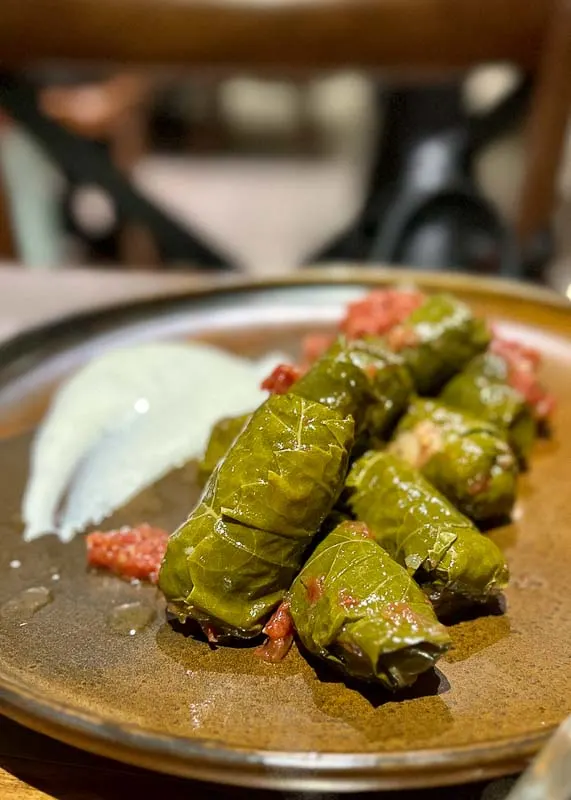
Stuffed vine leaves are called dolmathakia or dolmades and are a traditional Cretan food. The grape leaves are used to form little packets that are loaded with a rice mixture featuring minced meat, pine nuts seasoned with mint or sometimes finely chopped vegetables.
When they’re in season, courgette (zucchini) flowers might be folded into the vine leaves for an added splash of yellow. They can also be stuffed with a similar mixture used for dolmades.
Greek Dips
Tzatziki is a mix of creamy Greek yoghurt, grated cucumber and garlic with a dash of olive oil.
Tahini is a creamy dip made from sesame seeds, olive oil and fresh lemon juice.
Taramasalata is a pale pinkish-coloured dip made from fish roe. It’s delicious.
Fava is a dip made from split yellow peas and onion, not fava beans as in other parts of the Mediterranean. It’s served with a drizzle of hot olive oil and is great to dip your pita bread into.
Melitzanosalata or aubergine (egg-plant) dip is a delicious roasted dip. It’s made with garlic, extra virgin olive oil, vinegar, and parsley and has a nice smokey flavour. It’s similar to Baba Ganoush but without the tahini and smoked paprika.
All of these dips are just perfect for diving into with warm pitta bread or when used as a sauce with meatballs.
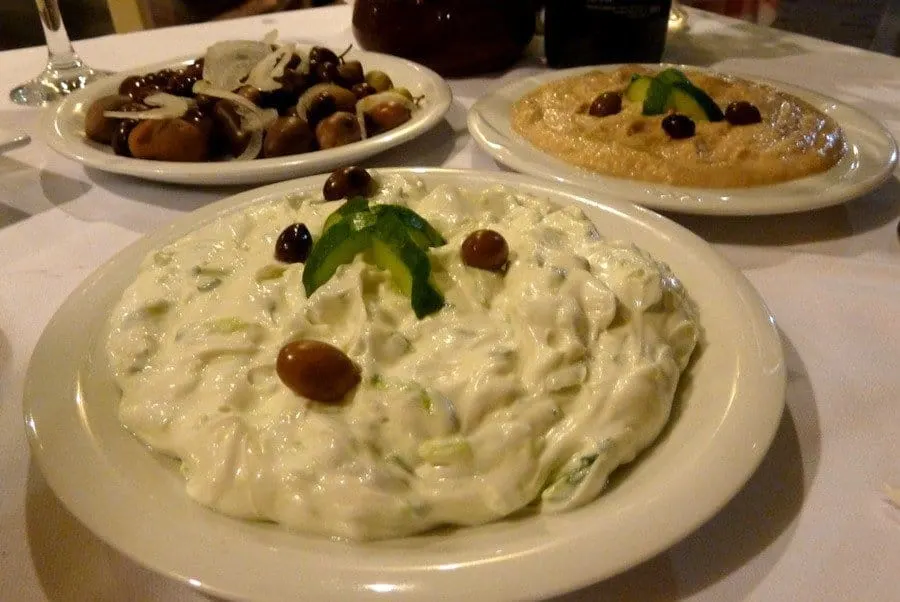
Tzatziki, Taramasalata and olives
Olives and Olive Oil
Olive oil has been a Cretan staple since ancient times. Did you know that the first-ever olive press was discovered on the island of Crete around 1600 BC?
There must be a million olive trees in Crete, and Cretan cuisine includes a bowl of gleaming olives at almost every meal. There are many varieties, but the most well-known Greek olives are Kalamata olives.
All olives start out green and turn black when left on the tree to ripen, so the colour of the olives on your table depends on the stage at which they were picked. Olives taste bitter when freshly picked, thanks to a compound called oleuropein, so they must be cured in brine or dry salt before they’re ready to eat.
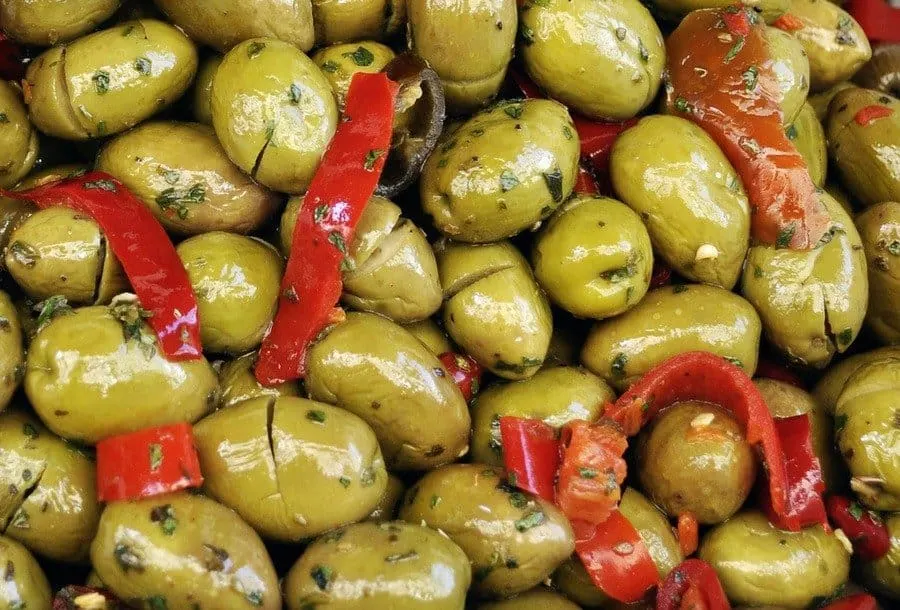
Olive Oil Tasting
One of my favourite food experiences in Crete was an olive oil tasting in an olive grove followed by a tour of the olive mills and lunch.
There are particular flavours to look for in olive oil and different levels of fruitiness, pungency and bitterness.
Check rates and availability for olive oil tasting in Crete
Greek Salad (village salad or farmer’s salad)
Greek salad is my all-time favourite salad, and I’m always eager for the arrival of summer in the UK when it’s finally warm enough to eat outdoors. I make myself a big bowl of Greek salad and eat it al fresco while I dream of the summer months ahead.
Cretan salad is a mix of chopped cucumber, ripe tomatoes, thin slices of red onion and salty olives, all topped with a slab of crumbly feta cheese.
This deliciously fresh salad is seasoned with salt and oregano and drizzled with a generous slug of Cretan olive oil that you can mop up with a hunk of crusty bread.
Somehow, these basic ingredients are transformed like magic into the best salad ever!
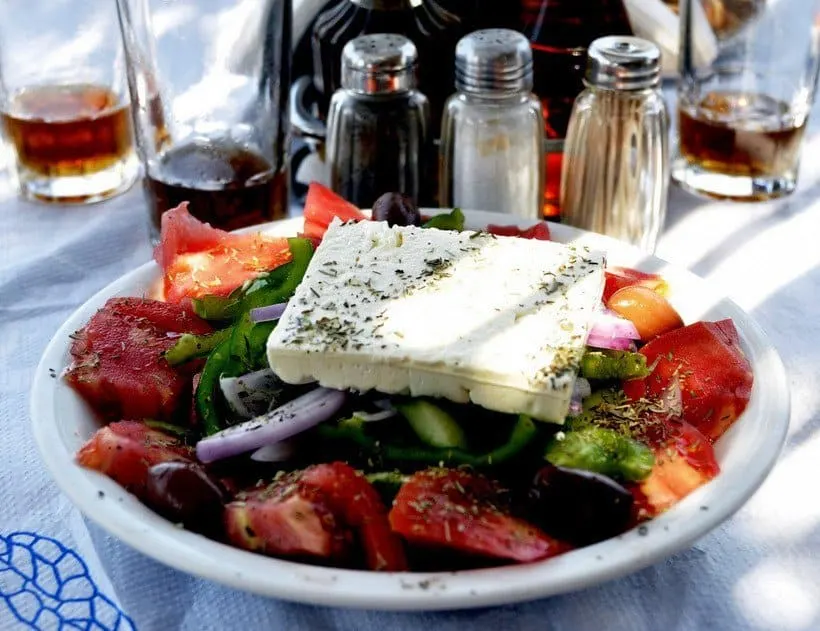 Greek Salad – one of the best things about Greece!
Greek Salad – one of the best things about Greece!
Check rates and availability for this full day Cretan wine, olive oil tasting and food tour.
Furnos aka The Greek Pie Shop
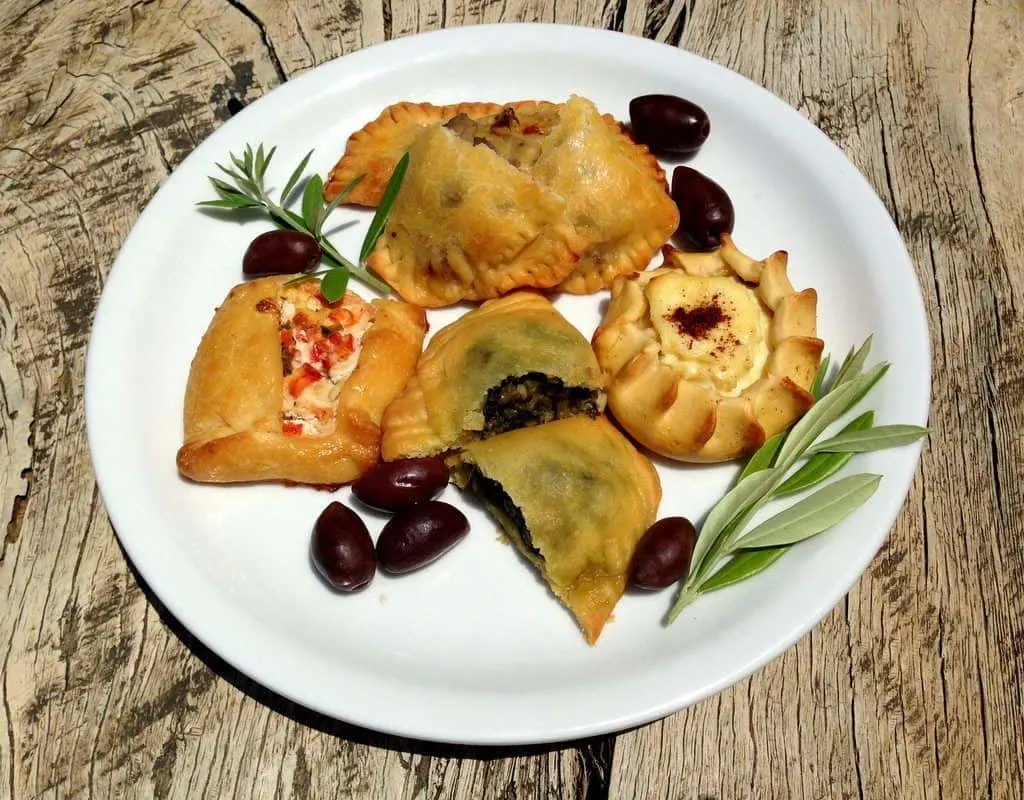
If you didn’t try a Cretan cheese pie on your visit to Crete, did you even go to Crete? Pie shops can be found everywhere, and we discovered a fabulous one in Rethymno’s old town.
It was just a hatch in the wall opening onto a narrow street, but the counter was laden with all types of pastries and pies, sesame seed-covered rings of doughy bread, and both sweet and savoury filo pastry treats. We may have overdone it a bit on the Spanakopita and the cheese and onion-filled filo because it all looked and tasted so fab!
Who ate all the pies? Me!
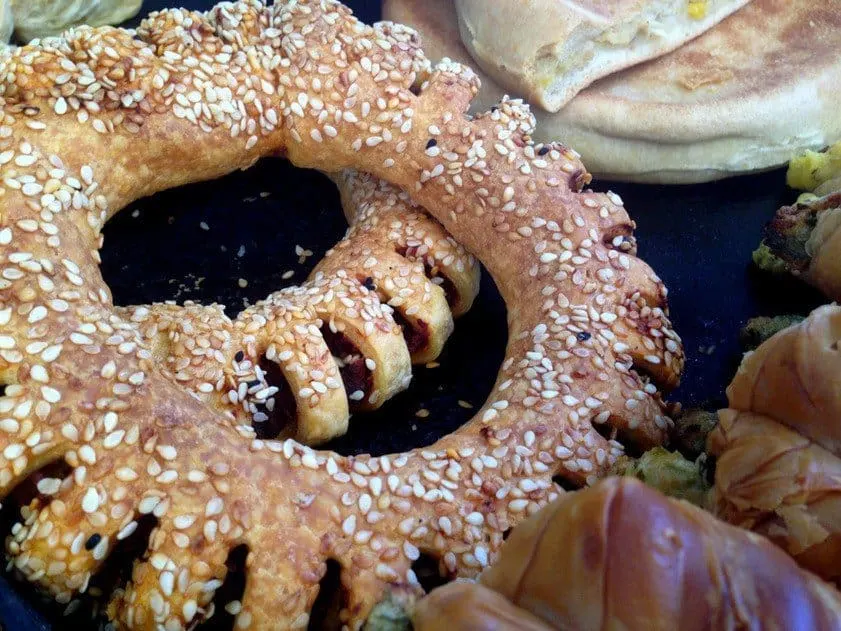
Spanakopita is a large filo pastry pie cut into slices. The layers of pastry are filled with spinach and feta or other Cretan cheeses. Sometimes onions and the wild greens or ‘horta’ that grow in Crete are added to the mix.
The outer layers of pastry are crisp and flaky, but underneath, the layers get denser from the moisture of the filling to give a gorgeous chewy texture.
Hortopitakia are similar but in the form of small semi-circular filled pies instead of filo pastry. They’re just as good.
You’ll also find tiropita, another savoury pie with a filo (phyllo) crust in Crete. It’s similar to Spanokopita but rather than spinach, herbs, and feta tiropita is stuffed with a mixture of cheese and eggs.
Read More: Why you should go to Rethymno, Crete
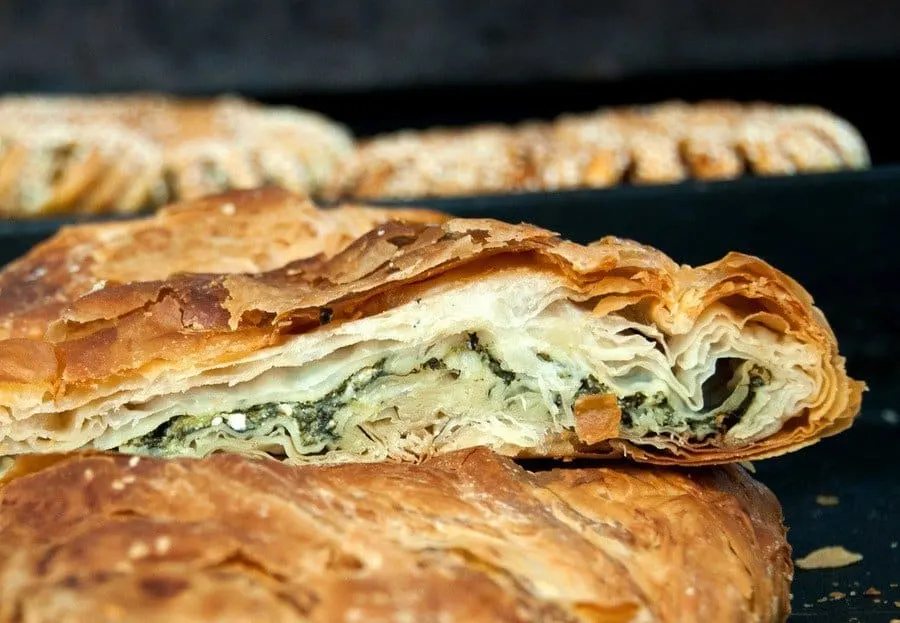
Looking for somewhere to stay in Crete? Check rates and availability
Cretan Main Dishes
If you’ve still got room for a main dish after your table full of Cretan starters then choose from some of these traditional recipies.
Keftedes are meatballs made with minced lamb, lightly herbed with mint. They sometimes have a small scoop of local cheese in the centre, and they always taste great with a dollop of tzatziki on the side.
Souvlaki is deliciously tender skewers of tender pork, lamb or chicken marinated in a red wine sauce and then grilled over hot coals or open fire. Souvlaki is often served with salad, pitta bread and french fries.
Moussaka is a Crete food classic that’s delicious in both meat and vegetarian forms. Layers of aubergine and potato are alternated with a rich minced lamb and tomato sauce and then topped with a thick layer of béchamel sauce before being baked in the oven. Perfect with a bottle of local wine!
Kleftiko is a joint of lamb cooked with garlic, tomatoes and potatoes. It’s slow-cooked in a clay oven at low heat until the meat is so tender it falls off the bone.
The name kleftiko means stolen, and it’s said to originate from the time of the Greek Revolution when bands of revolutionaries would steal lambs or goats. They would cook the meat in underground ovens so the delicious smell wouldn’t give them away!
Stifado is a traditional dish that’s ideal on a cooler evening. This warming beef stew is cooked in red wine and served with rice.
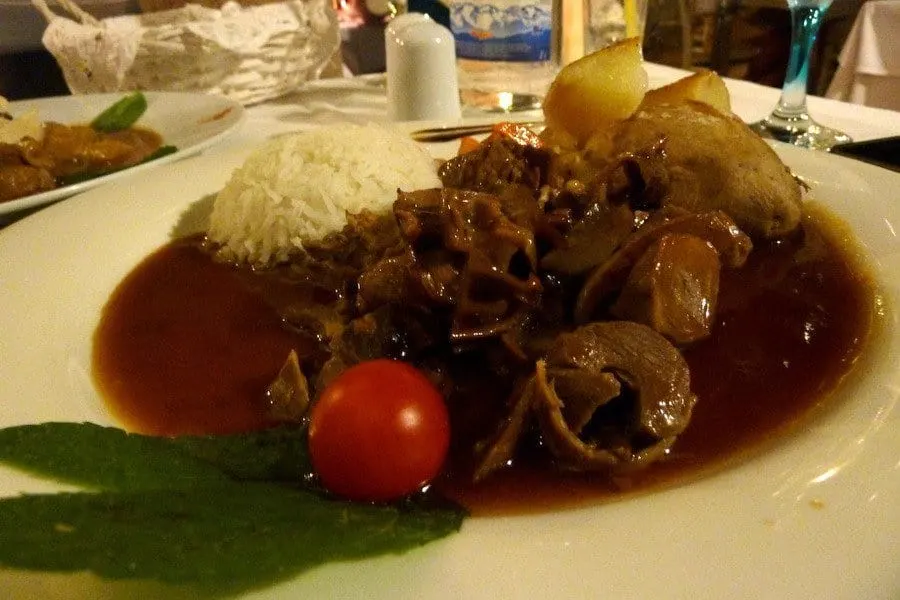
Looking for somewhere to stay in Crete? Check rates and availability
Vegetarian food in Greece
If meat’s not your thing, ask the waiter if there are any orfana dishes on the menu. This means orphan and indicates the meatless version of Cretan dishes – so your dolmades orfana would be filled with rice and vegetables, and moussaka orfana replaces the lamb mince with a vegetable sauce.
Read more: A day in Mykonos
Greek Desserts
Kalitsounia
Kalitsounia are cheese pies – yes, more cheese and pastry, but these little cinnamon-dusted bites of deliciousness are a bit different from the ones I mentioned earlier.
They’re shaped by hand into tiny cups with pinched edges and an open centre that’s home to the cheesy lushness. Here’s the surprise: these little cheese pies are sweet and are even more delicious drizzled with Cretan honey.
The pastry is slightly sweet and doughy, and the filling is made from a soft cheese like Malaka or Mizithra cheese, but not feta, as it’s too salty.
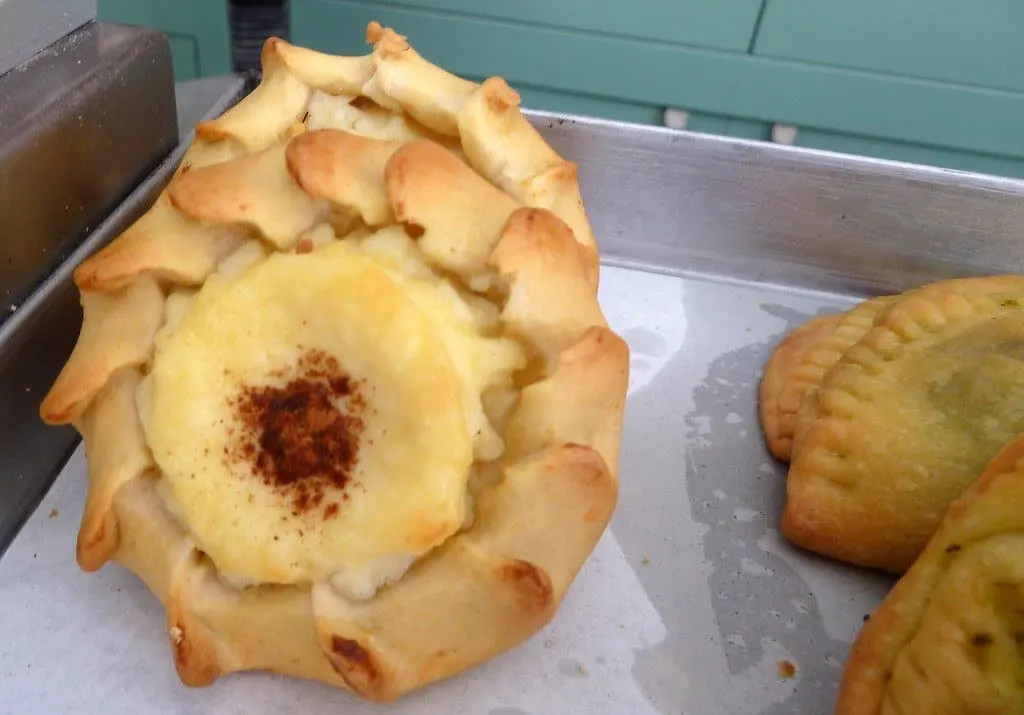
Kaltsounia – Cretan Cheese Pies
Baklava
Baklava is made with the thinnest layers of filo pastry between which you’ll discover chopped nuts and cinnamon. It’s drizzled with plenty of honey or syrup and come in handy bite-sized pieces. Look out for bird-nest style pastries made from thin strands of pastry all knitted together and filled with nuts and honey.
Halva
Many Cretan restaurants or traditional tavernas will usually serve a small plate of halva at the end of a meal, often with coffe.
Halva can be made with tahini (sesame) or semolina, and is a popular dish during Lent.
Loukoumades
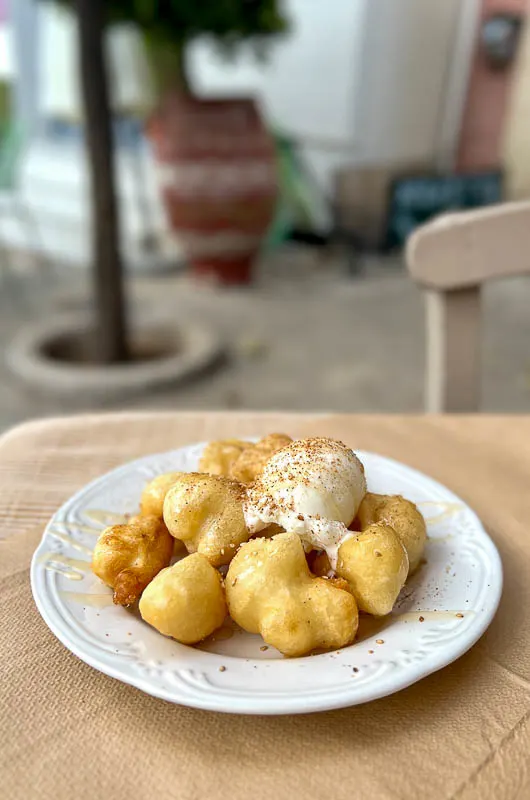
These small doughnuts are freshly fried and brought to your table served with a good drizzle of honey, cinnamon or syrup, and are delilcious. Loukoumades are very light so one or two at the end of your meal offers the perfect sweet finale, especially with a serving of ice cream.
The baker next door to our villa in Rethymno had some little pies shaped like pasties on his counter. They were filled with stewed apples, picked straight from his garden, and dusted with powdered sugar and cinnamon. I found them utterly irresistible!
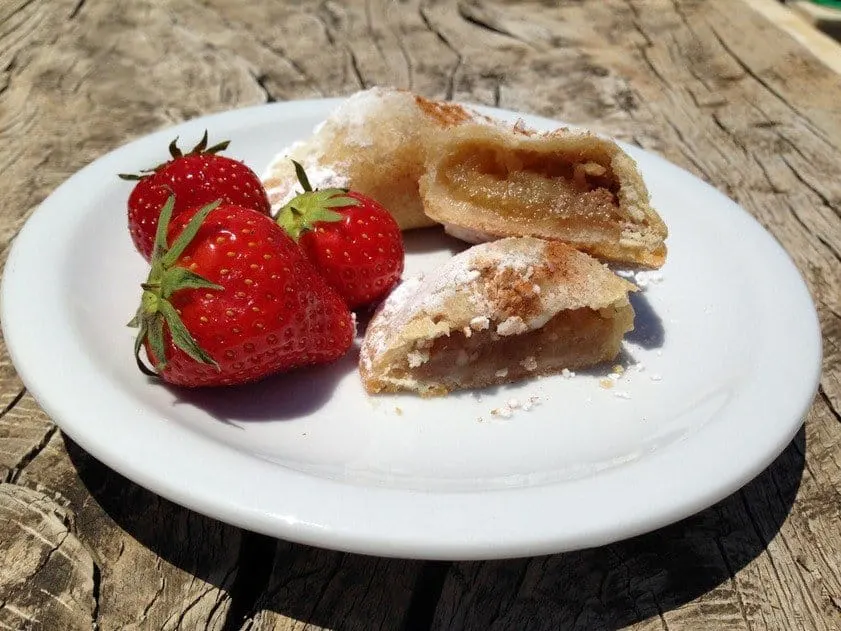
Crete Wine
Crete is one of Greece’s biggest wine producers, and we’ve had some excellent Cretan wine during our visits to Crete. We also had some, let’s say, rustic local wines, but they were all reasonably quaffable. The best way to decide what you like best is to go to a winery for a wine tasting.
They’ve been making wine on Crete since the Bronze Age, thanks to its Mediterranean climate, hot winds from North Africa, and cooling breezes off the Aegean Sea. In Roman times, Crete was famous for a sweet wine known as Protropos.
There are over 60 wineries on Crete, including several world-class wine producers. Local white wine produced in Crete includes Vilana, one of the most popular Cretan wine grape varieties, Vidiano and Dafni. Popular red wine varieties include Kotsifali, Liatiko and the renowned Romeiko.
If you’d like to learn more about winemaking in Crete and sample some of the local Cretan wines, you could visit the Lyrakis Winery and Tasting Room in Eastern Crete or take a day trip for a Cretan wine, olive oil and food tour.
Raki – Cretan Brandy
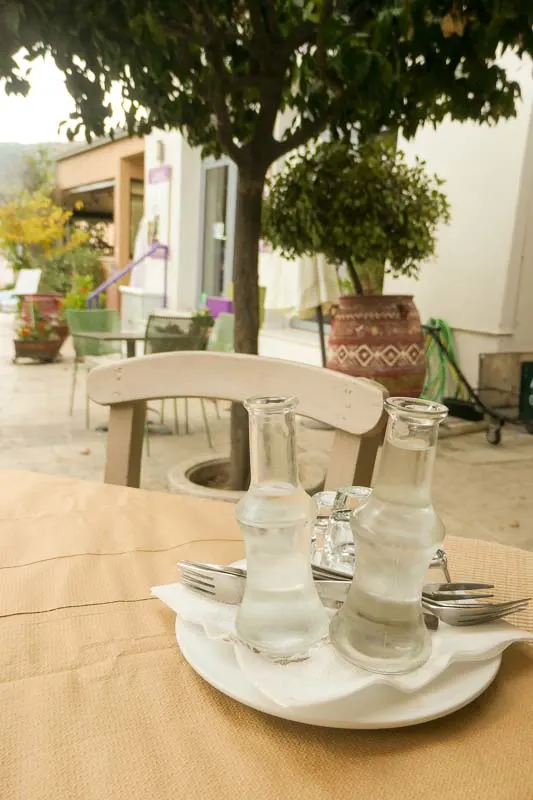
Raki, also called Tsikoudia in parts of Crete, is an alcoholic beverage made from the pips and skins left over after the grapes have been used to make wine. It’s made the same way as grappa in Italy, although it’s not as strong.
Raki is served in small shot glasses with a selection of mezes or olives. It’s traditionally drunk neat, without ice or water, and has a unique taste. Raki is said to ‘make a strange feel like a friend’…
You’ll find it in most tavernas, bars and restaurants and complimentary shot is often served at the end of your meal as a digestive. We came to like it by the end of our visit to Crete but it took a bit of getting used to!
Where to eat tradtional Cretan food in Crete
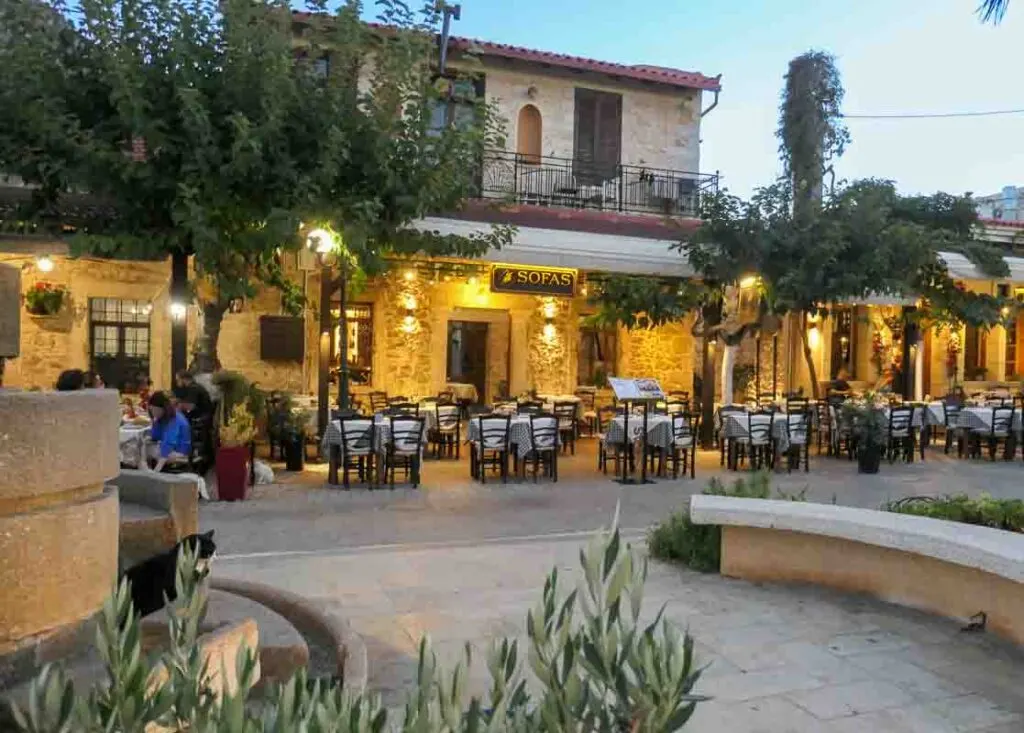
The best restaurants to eat locally grown and cooked Cretan food are family-owned and run taverns. Try and visit a traditional Cretan mountain village or somewhere off the beaten track for a meal cooked in a traditional way at a Cretan tavern.
The following are ones that I’ve tried personally which offer high quality home-cooked traditional dishes made from recipes passed down through the generations. You’ll find excellent, authentic food, a taste of Cretan culture and the warmest of welcomes. The people of Crete are incredibly hospitable.
These small tavernas are very local and don’t have websites so you’ll have to try your luck but I can assure you it’s worth it.
Platanos Tavern The Square Fourni, Crete 72400. No website but it’s a tiny village square so you can’t miss it.
Likastos Tavern in the traditional village of Archanes near Heraklion. There’s no website but you’ll find it at Central Square Archanes, Archanes, Crete Greece +30 281 075 2433
Stou Stereou Beautiful homemade Cretan food in the square in Old Town Hersonissos. Eleutherias Square, Chersonisos, 700 14
Taverna Christinis, Limnes 724 00
Peskesi Restaurant, Heraklion. Traditional Cretan food with a modern twist in a beautiful setting and upscale restaurant.
Have you eaten Cretan food – what was you favourite dish?
Pin it for later!
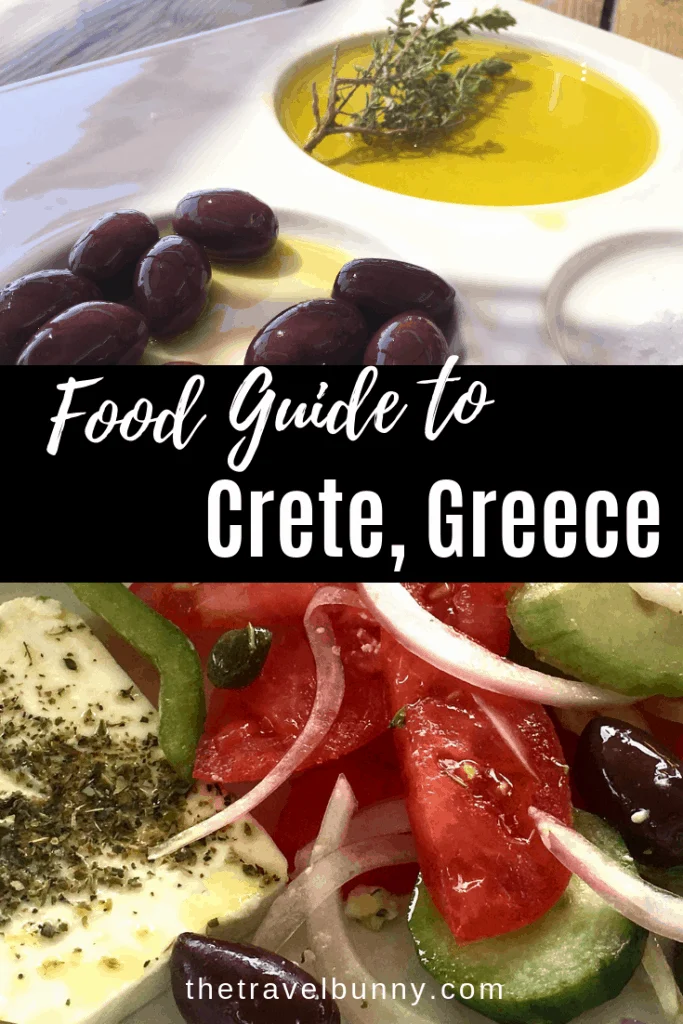
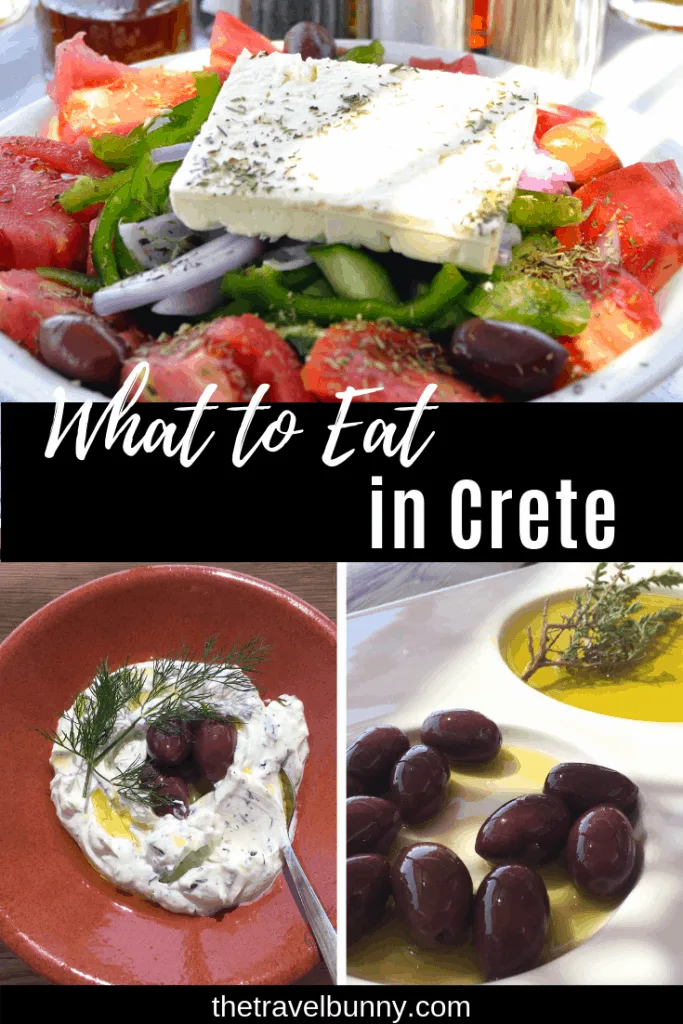

Suzanne Jones is a full-time travel blogger and writer at The Travelbunny website which she started in 2011 during her time as a professional travel planner. This serial traveller enjoys exploring new destinations, culinary encounters and the outdoors. When she’s not indulging her wanderlust or writing about her adventures you’ll most likely find Suzanne, camera in hand, enjoying coastal walks on England’s South Coast.
Suzanne also runs Hello Sussex a website which showcases the best of East & West Sussex. Read more about Suzanne here…

Lisa Schad
Tuesday 3rd of September 2019
I was in Greece this spring 4/2019 for a month with Crete being the first stop. I’m so glad I choose Crete among other islands. Crete has the best overall cuisine. If your planning santorini and your in Crete id highly suggest a day trip over instead and spend more time in Crete, if your smart. Try the sauté mix greens while in Crete. It’s there version of spinach/ kale. Unbelievable!! My best meal was a Shepard’s meal below the cave of Zeus. Everything came from his farm & organic. The only thing he bought was bread. This was my second time to Greece and I’m planning my third for next year. I’m adding a few different islands like Rhodes & Milos next time and definitely Crete again, the west side this time and whatever I can get away with.
Suzanne Jones
Tuesday 3rd of September 2019
Crete is the perfect Greek island if you're into good, fresh, healthy food. I loved the food there. I was in Ios earlier this year and had some excellent food there as well. Sounds like you're a big fan of the Greek islands - me too!
Peko Art
Sunday 11th of March 2018
I love the filled Zucchini blossoms
Suzanne Jones
Sunday 11th of March 2018
They’re delicious- I’ve had them in Italy but not Greece!
pip
Thursday 22nd of October 2015
I had the best food in Crete and when I returned home, kept wanting to recreate the experience...Greek salads are tbe best!
Tanuja Balaji
Tuesday 1st of November 2016
Travelling soon to Crete,want to try all the yummy food and wine an and not to mention Raki too????
Suzanne Jones
Sunday 25th of October 2015
I love Greek salads too - especially when it's warm enough to eat al fresco :)
Mouth-watering Mezze and a Giveaway | The Travelbunny
Friday 14th of August 2015
[…] pages I was transported into full-on feast of mouth-watering mezze. If you read my last post about Crete’s best eats you’ll know that I’m a big fan of Mezze so I was keen to get stuck in. The book is […]
Suze The Luxury Columnist
Sunday 9th of August 2015
Cretan brandy sounds quite lethal! When I went to Greece, the vine leaves were my favourite but all of it is so healthy, I love it!
Suzanne Jones
Sunday 9th of August 2015
It's that Greek salad that does it for me - summer on a plate! Dolmades are delicious too - the Raki is an acquired taste!